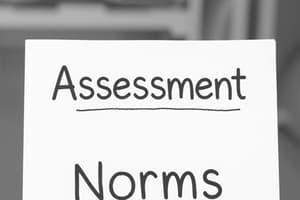Podcast
Questions and Answers
What is the primary purpose of a formative test?
What is the primary purpose of a formative test?
- To evaluate student learning at the end of a lesson
- To identify students' strengths and weaknesses at the beginning of a lesson or unit
- To predict student potential in a particular area
- To monitor student progress and provide feedback during the learning process (correct)
What is the term for the consistency of test results over time?
What is the term for the consistency of test results over time?
- Objectivity
- Reliability (correct)
- Validity
- Norm-referenced
What type of test item requires a brief response?
What type of test item requires a brief response?
- True/False
- Essay
- Multiple Choice
- Short Answer (correct)
What is the purpose of a diagnostic test?
What is the purpose of a diagnostic test?
What is a test blueprint?
What is a test blueprint?
What is the term for a test that compares student performance to that of a larger group?
What is the term for a test that compares student performance to that of a larger group?
Flashcards are hidden until you start studying
Study Notes
Types of Tests
- Formative Tests: Used to monitor student progress and provide feedback during the learning process.
- Summative Tests: Used to evaluate student learning at the end of a lesson, unit, or course.
- Diagnostic Tests: Used to identify students' strengths and weaknesses at the beginning of a lesson or unit.
- Achievement Tests: Used to measure student learning at the end of a lesson, unit, or course.
- Aptitude Tests: Used to predict student potential in a particular area.
Test Characteristics
- Validity: The extent to which a test measures what it claims to measure.
- Reliability: The consistency of test results over time.
- Objectivity: The degree to which test scores are free from bias.
- Norm-referenced: Tests that compare student performance to that of a larger group.
- Criterion-referenced: Tests that measure student performance against a specific standard or criterion.
Test Items
- Multiple Choice: Questions with a set of possible answers.
- True/False: Questions that require a true or false response.
- Short Answer: Questions that require a brief response.
- Essay: Questions that require a longer, written response.
- Open-ended: Questions that allow students to respond in their own words.
Test Preparation
- Test Blueprint: A detailed plan outlining the content and format of the test.
- Item Analysis: The process of reviewing and refining test questions to ensure they are effective and valid.
- Test Review: A review of the test content and format to ensure it is fair and valid.
Types of Tests
- Formative tests are used to monitor student progress and provide feedback during the learning process
- Summative tests are used to evaluate student learning at the end of a lesson, unit, or course
- Diagnostic tests are used to identify students' strengths and weaknesses at the beginning of a lesson or unit
- Achievement tests measure student learning at the end of a lesson, unit, or course
- Aptitude tests predict student potential in a particular area
Test Characteristics
- Validity refers to the extent to which a test measures what it claims to measure
- Reliability refers to the consistency of test results over time
- Objectivity refers to the degree to which test scores are free from bias
- Norm-referenced tests compare student performance to that of a larger group
- Criterion-referenced tests measure student performance against a specific standard or criterion
Test Items
- Multiple-choice questions have a set of possible answers
- True/false questions require a true or false response
- Short-answer questions require a brief response
- Essay questions require a longer, written response
- Open-ended questions allow students to respond in their own words
Test Preparation
- A test blueprint is a detailed plan outlining the content and format of the test
- Item analysis is the process of reviewing and refining test questions to ensure they are effective and valid
- A test review involves reviewing the test content and format to ensure it is fair and valid
Studying That Suits You
Use AI to generate personalized quizzes and flashcards to suit your learning preferences.




